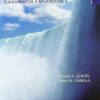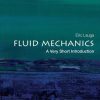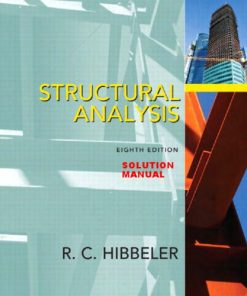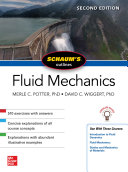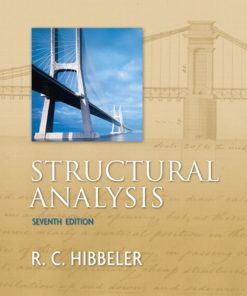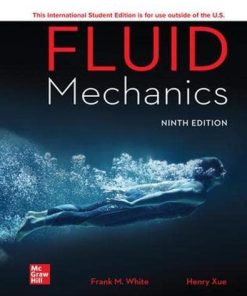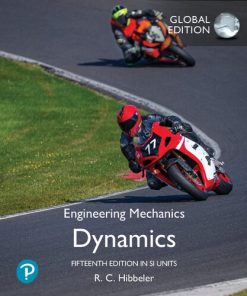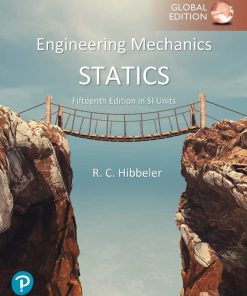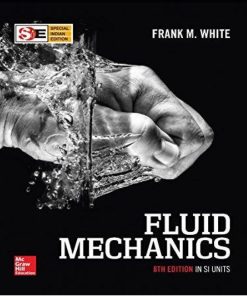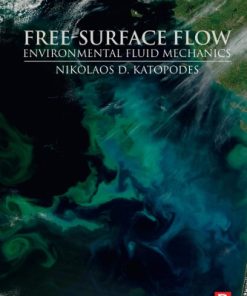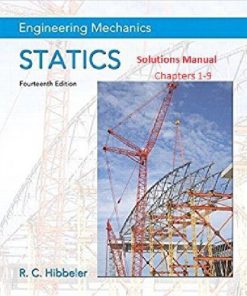Fluid Mechanics 2nd Edition by Russell Hibbeler 0134626055 9780134626055
$50.00 Original price was: $50.00.$25.00Current price is: $25.00.
Fluid Mechanics 2nd Edition by Russell C. Hibbeler – Ebook PDF Instant Download/DeliveryISBN: 0134626055, 9780134626055
Full download Fluid Mechanics 2nd Edition after payment.

Product details:
ISBN-10 : 0134626055
ISBN-13 : 9780134626055
Author: Russell C. Hibbeler
For Fluid Mechanics courses found in Civil and Environmental, General Engineering, and Engineering Technology and Industrial Management departments. Fluid Mechanics is intended to provide a comprehensive guide to a full understanding of the theory and many applications of fluid mechanics. The text features many of the hallmark pedagogical aids unique to Hibbeler texts, including its student-friendly clear organization. The text supports the development of student problem-solving skills through a large variety of problems, representing a broad range of engineering disciplines that stress practical, realistic situations encountered in professional practice, and provide varying levels of difficulty. The text offers flexibility in that basic principles are covered in chapters 1-6, and the remaining chapters can to be covered in any sequence without the loss of continuity. Updates to the 2nd Edition result from comments and suggestions from colleagues, reviewers in the teaching profession, and many of the author’s students, and include expanded topic coverage and new Example and Fundamental Problems intended to further students’ understanding of the theory and its applications. Also available with Mastering Engineering Mastering™ Engineering is an online homework, tutorial, and assessment program designed to work with this text to engage students and improve results. Interactive, self-paced tutorials provide individualized coaching to help students stay on track. With a wide range of activities available, students can actively learn, understand, and retain even the most difficult concepts. The text and Mastering Engineering work together to guide students through engineering concepts with a multi-step approach to problems. Note: You are purchasing a standalone product; Mastering™ Engineering does not come packaged with this content. Students, if interested in purchasing this title with Mastering Engineering ask your instructor for the correct package ISBN and Course ID. Instructors, contact your Pearson representative for more information. If you would like to purchase both the physical text and Mastering Engineering, search for: 0134676610 / 9780134676616 Fluid Mechanics Plus Mastering Engineering with Pearson eText — Access Card Package, 2/e Package consists of: 0134628772 / 9780134628776 Mastering Engineering with Pearson eText — Standalone Access Card — for Fluid Mechanics 013464929X / 9780134649290 luid Mechanics
Fluid Mechanics 2nd Table of contents:
Chapter 1 Fundamental Concepts
Chapter Objectives
1.1 Introduction
Branches of Fluid Mechanics
Historical Development
1.2 Characteristics of Matter
Solid
Liquid
Gas
Continuum
1.3 Systems of Units
U.S. Customary Units
Temperature
SI Units
Temperature
Conversion of Units
Prefixes
1.4 Calculations
Dimensional Homogeneity
Rounding off Numbers
Calculation Procedure
1.5 Problem Solving
Solution
Solution
1.6 Some Basic Fluid Properties
Density
Liquid
Gas
Specific Weight
Specific Gravity
Bulk Modulus
Liquid
Gas
Ideal Gas Law
Solution
Solution
1.7 Viscosity
Physical Cause of Viscosity
Newton’s Law of Viscosity
Shear Stress
Shear Strain
Newtonian Fluids
Non-Newtonian Fluids
Inviscid and Ideal Fluids
Pressure and Temperature Effects
Kinematic Viscosity
1.8 Viscosity Measurement
Solution
Fluid Description
Analysis
Solution
Fluid Description
Analysis
1.9 Vapor Pressure
Cavitation
1.10 Surface Tension and Capillarity
Surface Tension
Liquid Drops
Capillarity
References
Problems
Sec. 1.1-1.6
Sec. 1.7-1.8
Sec. 1.9-1.10
Conceptual Problems
Chapter Review
Chapter 2 Fluid Statics
Chapter Objectives
2.1 Pressure
Pascal’s Law
Solution
Fluid Description
Analysis
2.2 Absolute and Gage Pressure
Solution
Fluid Description
Analysis
2.3 Static Pressure Variation
2.4 Pressure Variation for Incompressible Fluids
Pressure Head
Solution
Fluid Description
Analysis
2.5 Pressure Variation for Compressible Fluids
Constant Temperature
Solution
Fluid Description
Analysis
Incompressible Gas
Compressible Gas
2.6 Measurement of Static Pressure
Barometer
Manometer
Manometer Rule
Differential Manometer
Bourdon Gage
Pressure Transducers
Other Pressure Gages
Solution
Fluid Description
Analysis
Solution
Fluid Description
Analysis
Solution
Fluid Description
Analysis
2.7 Hydrostatic Force on a Plane Surface—Formula Method
Resultant Force
Location of the Resultant Force
The yP Coordinate
The xP Coordinate
Symmetrical Plate
Solution
Fluid Description
Analysis
Solution
Fluid Description
Analysis
Solution
Fluid Description
Analysis
2.8 Hydrostatic Force on a Plane Surface—Geometrical Method
Resultant Force
Location
Plate Having Constant Width
Solution
Fluid Description
Analysis I
Loading
Resultant Forces
Location
Analysis II
Loading
Resultant Forces
Location
Solution
Fluid Description
Loading
Resultant Force
Location
2.9 Hydrostatic Force on a Plane Surface—Integration Method
Resultant Force
Location
Solution
Fluid Description
Resultant Force
Location
Solution
Fluid Description
Resultant Force
Location
2.10 Hydrostatic Force on an Inclined Plane or Curved Surface Determined by Projection
Horizontal Component
Vertical Component
Liquid below Plate
Gas
Solution
Fluid Description
Horizontal Force Component
Vertical Force Component
Resultant Force
Solution
Fluid Description
Analysis I
Horizontal Force Component
Vertical Force Component
Resultant Force
Reactions
Analysis II
Solution
Fluid Description
Analysis
2.11 Buoyancy
Hydrometer
Solution
Fluid Description
Analysis
Part (a)
Part (b)
2.12 Stability
Solution
Fluid Description
Analysis
2.13 Constant Translational Acceleration of a Liquid
Constant Horizontal Acceleration
Vertical Element
Horizontal Element
Constant Vertical Acceleration
Horizontal Element
Vertical Element
Solution
Fluid Description
Analysis
Solution
Fluid Description
Analysis
Side of Tank
Bottom of Tank
2.14 Steady Rotation of a Liquid
Vertical Element
Ring Element
Solution
Fluid Description
Analysis
References
Fundamental Problems
Sec. 2.1-2.5
Sec. 2.6
Sec. 2.7-2.9
Sec. 2.10
Sec. 2.11-2.12
Problems
Sec. 2.1-2.5
Sec. 2.6
Sec. 2.7-2.9
Sec. 2.10
Sec. 2.11-2.12
Sec. 2.13-2.14
Conceptual Problems
Chapter Review
Chapter 3 Kinematics of Fluid Motion
Chapter Objectives
3.1 Types of Fluid Flow
Classification of Flow Based on Its Frictional Effects
Classifications of Flow Based on Dimension
Classification of Flow Based on Space and Time
3.2 Graphical Descriptions of Fluid Flow
Streamlines
Streamtubes
Equation of a Streamline
Pathlines
Streaklines
Optical Methods
Computational Fluid Dynamics
3.3 Fluid Flow Descriptions
Lagrangian Description—System Approach
Eulerian Description—Control Volume Approach
Solution
Fluid Description
Analysis
Solution
Fluid Description
Pathline
Streamline
Solution
Fluid Description
Analysis
3.4 Fluid Acceleration
Local Acceleration
Convective Acceleration
Three-dimensional Flow
Solution
Fluid Description
Analysis
Solution
Flow Description
Analysis
Velocity
Acceleration
Solution
Fluid Description
Analysis
3.5 Streamline Coordinates
Velocity
Acceleration
Local Change
Convective Change
Resultant Acceleration
Solution
Fluid Description
Streamline Acceleration Component
Normal Acceleration Component
Acceleration
References
Fundamental Problems
Sec. 3.1-3.3
Sec. 3.4
Sec. 3.5
Problems
Sec. 3.1-3.3
Sec. 3.4
Sec. 3.5
Chapter Review
Chapter 4 Conservation of Mass
Chapter Objectives
4.1 Volumetric Flow, Mass Flow, and Average Velocity
Volumetric Flow
Average Velocity
Mass Flow
Solution
Fluid Description
Analysis
4.2 Finite Control Volumes
Open Control Surfaces
Velocity
Steady Flow
4.3 The Reynolds Transport Theorem
Fluid Property Description
The Reynolds Transport Theorem
Applications
4.4 Conservation of Mass
Special Cases
Solution
Fluid Description
Control Volume
Continuity Equation
Solution
Fluid Description
Control Volume
Continuity Equation
Ideal Gas Law
Solution
Fluid Description
Control Volume
Continuity Equation
Ideal Gas Law
Solution
Fuel Description
Control Volume
Continuity Equation
Solution
Fluid Description
Control Volume I
Conservation of Mass
Control Volume II
Conservation of Mass
References
Fundamental Problems
Sec. 4.1-4.2
Sec. 4.4
Problems
Sec. 4.1-4.2
Sec. 4.3
Sec. 4.4
Conceptual Problems
Chapter Review
Chapter 5 Work and Energy of Moving Fluids
Chapter Objectives
5.1 Euler’s Equations of Motion
s Direction
n Direction
Steady Horizontal Flow of an Ideal Fluid
Solution
Fluid Description
Analysis
5.2 The Bernoulli Equation
Limitations
5.3 Applications of the Bernoulli Equation
Flow from a Large Reservoir
Flow around a Curved Boundary
Flow in an Open Channel
Flow in a Closed Conduit
Venturi meter
Solution
Fluid Description
Bernoulli Equation
Solution
Fluid Description
Bernoulli Equation
Solution
Fluid Description
Analysis
Continuity Equation
Bernoulli Equation
Solution
Fluid Description
Bernoulli Equation
Continuity Equation
Solution
Fluid Description
Bernoulli Equation
5.4 Energy and Hydraulic Grade Lines
Solution
Fluid Description
Bernoulli Equation
EGL and HGL
Solution
Fluid Description
Energy Grade Line
Hydraulic Grade Line
Solution
Fluid Description
Bernoulli Equation
EGL and HGL
5.5 The Energy Equation
System Energy
Heat Energy
Work
Flow Work
Shaft Work
Shear Work
Energy Equation
Incompressible Flow
Compressible Fluid
Power and Efficiency
Nonuniform Velocity
Solution
Fluid Description
Control Volume
Energy Equation
Power
Solution
Fluid Description
Control Volume
Energy Equation
Solution
Fluid Behavior
Control Volume
Continuity Equation
Energy Equation
Solution
Fluid Description
Control Volume
Energy Equation
Power
EGL and HGL
References
Fundamental Problems
Sec. 5.2-5.3
Sec. 5.4
Sec. 5.5
Problems
Sec. 5.1
Sec. 5.2-5.3
Sec. 5.4-5.5
Conceptual Problems
Chapter Review
Chapter 6 Fluid Momentum
Chapter Objectives
6.1 The Linear Momentum Equation
Steady Flow
Free-Body Diagram
6.2 Applications to Bodies at Rest
Solution
Fluid Description
Control Volume and Free-Body Diagram
Continuity Equation
Bernoulli Equation
Linear Momentum
Solution
Fluid Description
Control Volume and Free-Body Diagram
Linear Momentum
Solution
Fluid Description
Control Volume and Free-Body Diagram
Bernoulli and Continuity Equations
Linear Momentum
Solution
Fluid Description
Control Volume and Free-Body Diagram
Linear Momentum
6.3 Applications to Bodies Having Constant Velocity
Solution
Fluid Description
Control Volume and Free-Body Diagram
Linear Momentum
Solution
Fluid Description
Control Volume and Free-Body Diagram
Linear Momentum
Power
6.4 The Angular Momentum Equation
Steady Flow
Solution
Fluid Description
Control Volume and Free-Body Diagram
Bernoulli Equation
Linear and Angular Momentum
Solution
Fluid Description
Control Volume and Free-Body Diagram
Velocity
Angular Momentum
Solution
Fluid Description
Control Volume and Free-Body Diagram
Continuity Equation
Angular Momentum
*6.5 Propellers and Wind Turbines
Propeller
Linear Momentum
Bernoulli Equation
Power and Efficiency
Wind Turbine
Power and Efficiency
Solution
Fluid Description
Analysis
6.6 Applications for Control Volumes Having Accelerated Motion
*6.7 Turbojets and Turbofans
*6.8 Rockets
Solution
Fluid Description
Analysis
Solution
Fluid Description
Analysis
References
Fundamental Problems
Sec. 6.1-6.2
Sec. 6.3
Problems
Sec. 6.1-6.2
Sec. 6.3
Sec. 6.4
Sec. 6.5-6.8
Conceptual Problems
Chapter Review
Chapter 7 Differential Fluid Flow
Chapter Objectives
7.1 Differential Analysis
7.2 Kinematics of Differential Fluid Elements
Translation
Linear Distortion
Rotation
Angular Distortion
7.3 Circulation and Vorticity
Circulation
Vorticity
Irrotational Flow
Solution
Fluid Description
Triangular Path
Circular Path
Solution
Fluid Description
Vorticity
Shear-Strain Rate
7.4 Conservation of Mass
Two-Dimensional Steady Flow of an Ideal Fluid
Cylindrical Coordinates
7.5 Equations of Motion for a Fluid Particle
7.6 The Euler and Bernoulli Equations
Two-Dimensional Steady Flow
The Bernoulli Equation
Solution
Fluid Description
Volumetric Dilatation Rate
Rotation
Pressure
7.7 Potential Flow Hydrodynamics
7.8 The Stream Function
Velocity Components
Volumetric Flow
Solution
Fluid Description
Stream Functions
Velocity
Solution
Fluid Description
Velocity
Stream Function
Solution
Fluid Description
Velocity
7.9 The Potential Function
Flow Net
Solution
Fluid Description
Analysis
Solution
Fluid Description
Analysis
7.10 Basic Two-Dimensional Flows
Uniform Flow
Line Source Flow
Line Sink Flow
Free-Vortex Flow
Circulation
Forced-Vortex Flow
Solution
Fluid Description
Free Vortex
Forced Vortex
7.11 Superposition of Flows
Uniform Flow Past a Half Body
Doublet
Uniform Flow around a Rankine Oval
Uniform Flow around a Cylinder
Uniform and Free-Vortex Flow around a Cylinder
Other Applications
Solution
Fluid Description
Analysis
Solution
Fluid Description
Analysis
7.12 The Navier-Stokes Equations
Cylindrical Coordinates
Solution
Fluid Description
Analysis
7.13 Computational Fluid Dynamics
The CFD Code
Input
Fluid Properties
Flow Phenomena
Geometry
Program
Finite Difference Method
Finite Element Method
Finite Control Volume Method
Output
General Considerations
References
Problems
Sec. 7.1-7.6
Sec. 7.7-7.9
Sec. 7.10-7.11
Sec. 7.12
Chapter Review
Chapter 8 Dimensional Analysis and Similitude
Chapter Objectives
8.1 Dimensional Analysis
8.2 Important Dimensionless Numbers
Euler Number
Reynolds Number
Froude Number
Weber Number
Mach Number
8.3 The Buckingham Pi Theorem
Solution
Define the Physical Variables
Select the Repeating Variables
Π Term, q = D
Dimensional Analysis
Solution
Define the Physical Variables
Select the Repeating Variables
Π1 Term q = FD
Dimensional Analysis
Π2 Term q = μ
Dimensional Analysis
Solution
Define the Physical Variables
Select the Repeating Variables
Π1 Term q = FD and Dimensional Analysis
Π2 Term q = μ and Dimensional Analysis
Π3 Term q = g and Dimensional Analysis
Solution
Define the Physical Variables
Select the Repeating Variables
Π Terms and Dimensional Analysis
8.4 Some General Considerations Related to Dimensional Analysis
8.5 Similitude
Geometric Similitude
Kinematic Similitude
Dynamic Similitude
Steady Flow through a Pipe
Open-Channel Flow
Ships
Review
Solution
Solution
Solution
Solution
References
Problems
Sec. 8.1–8.4
Sec. 8.5
People also search for Fluid Mechanics 2nd:
continuity equation in fluid mechanics
fundamentals of fluid mechanics
momentum equation fluid mechanics
cavitation in fluid mechanics
orifice in fluid mechanics
Tags: Fluid Mechanics, Russell Hibbeler, Environmental, General Engineering
You may also like…
Physics - Mechanics: Fluid Mechanics
Schaum’s Outline of Fluid Mechanics 2nd Edition by Merle Potter 1260462854 9781260462852
Engineering
Physics - Mechanics: Fluid Mechanics
Engineering - Mechanical Engineering & Dynamics
Engineering Mechanics: Dynamics, SI Units 15th Edition Russell Hibbeler
Engineering - Mechanical Engineering & Dynamics
Engineering - Aerospace Engineering
Engineering


